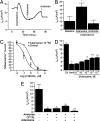Adenosine regulation of alveolar fluid clearance
- PMID: 17360481
- PMCID: PMC1820712
- DOI: 10.1073/pnas.0601117104
Adenosine regulation of alveolar fluid clearance
Abstract
Adenosine is a purine nucleoside that regulates cell function through G protein-coupled receptors that activate or inhibit adenylyl cyclase. Based on the understanding that cAMP regulates alveolar epithelial active Na(+) transport, we hypothesized that adenosine and its receptors have the potential to regulate alveolar ion transport and airspace fluid content. Herein, we report that type 1 (A(1)R), 2a (A(2a)R), 2b (A(2b)R), and 3 (A(3)R) adenosine receptors are present in rat and mouse lungs and alveolar type 1 and 2 epithelial cells (AT1 and AT2). Rat AT2 cells generated and produced cAMP in response to adenosine, and micromolar concentrations of adenosine were measured in bronchoalveolar lavage fluid from mice. Ussing chamber studies of rat AT2 cells indicated that adenosine affects ion transport through engagement of A(1)R, A(2a)R, and/or A(3)R through a mechanism that increases CFTR and amiloride-sensitive channel function. Intratracheal instillation of low concentrations of adenosine (< or =10(-8)M) or either A(2a)R- or A(3)R-specific agonists increased alveolar fluid clearance (AFC), whereas physiologic concentrations of adenosine (> or =10(-6)M) reduced AFC in mice and rats via an A(1)R-dependent pathway. Instillation of a CFTR inhibitor (CFTR(inh-172)) attenuated adenosine-mediated down-regulation of AFC, suggesting that adenosine causes Cl(-) efflux by means of CFTR. These studies report a role for adenosine in regulation of alveolar ion transport and fluid clearance. These findings suggest that physiologic concentrations of adenosine allow the alveolar epithelium to counterbalance active Na(+) absorption with Cl(-) efflux through engagement of the A(1)R and raise the possibility that adenosine receptor ligands can be used to treat pulmonary edema.
Conflict of interest statement
The authors declare no conflict of interest.
Figures





Similar articles
-
Interdependency of beta-adrenergic receptors and CFTR in regulation of alveolar active Na+ transport.Circ Res. 2005 May 13;96(9):999-1005. doi: 10.1161/01.RES.0000164554.21993.AC. Epub 2005 Mar 31. Circ Res. 2005. PMID: 15802612
-
The adenosine 2A receptor agonist GW328267C improves lung function after acute lung injury in rats.Am J Physiol Lung Cell Mol Physiol. 2012 Aug 1;303(3):L259-71. doi: 10.1152/ajplung.00395.2011. Epub 2012 Jun 1. Am J Physiol Lung Cell Mol Physiol. 2012. PMID: 22659881
-
Adenosine A2B receptor activation stimulates alveolar fluid clearance through alveolar epithelial sodium channel via cAMP pathway in endotoxin-induced lung injury.Am J Physiol Lung Cell Mol Physiol. 2020 Apr 1;318(4):L787-L800. doi: 10.1152/ajplung.00195.2019. Epub 2020 Mar 4. Am J Physiol Lung Cell Mol Physiol. 2020. PMID: 32129084
-
Alveolar epithelium: role in lung fluid balance and acute lung injury.Proc Am Thorac Soc. 2005;2(3):206-13. doi: 10.1513/pats.200501-009AC. Proc Am Thorac Soc. 2005. PMID: 16222039 Review.
-
Patterns of alveolar fluid clearance in heart failure.Int J Cardiol. 2008 Nov 12;130(2):125-30. doi: 10.1016/j.ijcard.2008.03.015. Epub 2008 Jun 24. Int J Cardiol. 2008. PMID: 18579236 Review.
Cited by
-
Hyperoxic Exposure of Immature Mice Increases the Inflammatory Response to Subsequent Rhinovirus Infection: Association with Danger Signals.J Immunol. 2016 Jun 1;196(11):4692-705. doi: 10.4049/jimmunol.1501116. Epub 2016 Apr 29. J Immunol. 2016. PMID: 27183577 Free PMC article.
-
Repression of the equilibrative nucleoside transporters dampens inflammatory lung injury.Am J Respir Cell Mol Biol. 2013 Aug;49(2):296-305. doi: 10.1165/rcmb.2012-0457OC. Am J Respir Cell Mol Biol. 2013. PMID: 23590299 Free PMC article.
-
Serotonin decreases alveolar epithelial fluid transport via a direct inhibition of the epithelial sodium channel.Am J Respir Cell Mol Biol. 2010 Jul;43(1):99-108. doi: 10.1165/rcmb.2008-0472OC. Epub 2009 Aug 28. Am J Respir Cell Mol Biol. 2010. PMID: 19717814 Free PMC article.
-
Analysis of purine receptor expression and functionality in alveolar epithelial cells.Purinergic Signal. 2020 Jun;16(2):213-229. doi: 10.1007/s11302-020-09696-0. Epub 2020 Mar 31. Purinergic Signal. 2020. PMID: 32236789 Free PMC article.
-
Nasal potential difference to detect Na+ channel dysfunction in acute lung injury.Am J Physiol Lung Cell Mol Physiol. 2011 Mar;300(3):L305-18. doi: 10.1152/ajplung.00223.2010. Epub 2010 Nov 26. Am J Physiol Lung Cell Mol Physiol. 2011. PMID: 21112943 Free PMC article. Review.
References
-
- Ware LB, Matthay MA. Am J Respir Crit Care Med. 2001;163:1376–1383. - PubMed
-
- Olivera W, Ridge K, Sznajder J. Am J Respir Crit Care Med. 1995;152:1229–1234. - PubMed
-
- Saldias FJ, Azzam ZS, Ridge KM, Yeldandi A, Rutschman DH, Schraufnagel D, Sznajder JI. Am J Physiol Lung Cell Mol Physiol. 2001;281:L591–L597. - PubMed
-
- Modelska K, Matthay M, Brown L, Deutch E, Lu L, Pittet J. Am J Physiol Lung Cell Mol Physiol. 1999;276:L844–L857. - PubMed
-
- Chunn JL, Young HW, Banerjee SK, Colasurdo GN, Blackburn MR. J Immunol. 2001;167:4676–4685. - PubMed
Publication types
MeSH terms
Substances
Grants and funding
- HL 31197/HL/NHLBI NIH HHS/United States
- R01 HL051173/HL/NHLBI NIH HHS/United States
- R37 HL031197/HL/NHLBI NIH HHS/United States
- HL 72871/HL/NHLBI NIH HHS/United States
- HL 51173/HL/NHLBI NIH HHS/United States
- R01 HL079094/HL/NHLBI NIH HHS/United States
- HL 71042/HL/NHLBI NIH HHS/United States
- HL 66211/HL/NHLBI NIH HHS/United States
- R01 ES015024/ES/NIEHS NIH HHS/United States
- R01 HL066211/HL/NHLBI NIH HHS/United States
- HL 79094/HL/NHLBI NIH HHS/United States
- R01 HL031197/HL/NHLBI NIH HHS/United States
- R01 HL072871/HL/NHLBI NIH HHS/United States
- ES 015024/ES/NIEHS NIH HHS/United States
- R01 HL071042/HL/NHLBI NIH HHS/United States
LinkOut - more resources
Full Text Sources
Other Literature Sources
Molecular Biology Databases
Research Materials

